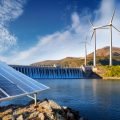As the global energy landscape shifts rapidly towards sustainability, solar photovoltaic (PV) technology is at the heart of this transformation. One of the most significant recent advancements in the solar industry is the emergence of N-type TOPCon (Tunnel Oxide Passivated Contact) solar panels, poised to challenge and possibly surpass the long-dominant P-type PERC (Passivated Emitter and Rear Cell) panels.
This article offers an in-depth engineering comparison between these two technologies, helping you make informed decisions for residential, commercial, or utility-scale projects.
🔍 Understanding the Fundamentals
P-Type (PERC) Solar Cells
- Doping Material: Boron
- Charge Carrier: Holes (majority)
- Cell Architecture: Rear-passivated to reduce recombination
- Limitations: Higher susceptibility to Light-Induced Degradation (LID) and Boron-Oxygen complex formation
P-type solar cells have been the industry workhorse due to their low cost and reliable performance. However, they exhibit performance degradation under prolonged light exposure, primarily due to the formation of boron-oxygen defects.
N-Type (TOPCon) Solar Cells
- Doping Material: Phosphorus
- Charge Carrier: Electrons (majority)
- Cell Architecture: Passivated contact with thin tunnel oxide + polysilicon layer
- Advantages: High open-circuit voltage (Voc), better passivation, minimal LID, excellent bifacial response
TOPCon is an advanced N-type architecture that enhances carrier selectivity and reduces recombination losses by introducing a tunnel oxide and doped polycrystalline silicon contact layer. This architecture allows for higher efficiency, improved thermal performance, and extended durability.
⚙️ Key Engineering Parameters Compared
| Parameter | P-Type PERC | N-Type TOPCon |
|---|---|---|
| Base Material | Boron-doped Silicon | Phosphorus-doped Silicon |
| Open Circuit Voltage (Voc) | ~650–670 mV | ~690–710 mV |
| Short Circuit Current (Jsc) | ~38–39 mA/cm² | ~40–41 mA/cm² |
| Efficiency | 18% – 20.5% | 21% – 23% |
| Temperature Coefficient (Pmax) | ~ -0.35%/°C | ~ -0.30%/°C |
| Degradation (First Year) | ~2% | ~1% or less |
| Annual Degradation | ~0.5–0.7% | ~0.3–0.4% |
| Bifacial Gain (if applicable) | 5–10% (limited) | 10–20% (typical) |
| Light-Induced Degradation (LID) | Moderate to High | Negligible |
| Potential-Induced Degradation (PID) | Higher Risk | Low to Negligible |
| Typical Warranty | 25 years (performance) | 30 years (performance) |
🧪 Material and Process Advantages of TOPCon
- Improved Passivation Quality
The tunnel oxide layer and doped polysilicon provide excellent surface and contact passivation, reducing recombination rates and boosting Voc. - High Bifaciality
TOPCon cells often exceed 80% bifaciality, allowing rear-side energy harvesting in reflective environments, increasing total yield significantly in bifacial installations. - Lower Degradation Mechanisms
The absence of boron in N-type wafers eliminates Boron-Oxygen defects, resulting in significantly reduced LID and PID effects—key for long-term reliability. - Better Thermal Coefficients
A superior temperature coefficient translates to less performance drop in high-heat environments, making TOPCon more suitable for tropical and arid regions. - Advanced Metallization Compatibility
TOPCon is compatible with existing industrial screen-printing and laser technologies, allowing manufacturers to scale with relatively minor capex upgrades.
💰 Cost vs. Performance: A Systems-Level View
While TOPCon panels are slightly more expensive per watt than PERC panels, the Levelized Cost of Electricity (LCOE) tells a different story:
- Higher yield per m² due to efficiency and bifacial gain
- Longer operational lifespan (30+ years)
- Lower annual degradation, resulting in higher energy retention
- Lower operation and maintenance costs due to better long-term performance
These factors make N-type TOPCon highly favorable for long-term investments, especially in utility-scale and commercial rooftop systems where space utilization and yield matter most.
📈 Market Outlook
- As per industry forecasts, N-type TOPCon is expected to overtake P-type in global shipments by 2026, driven by adoption from leading manufacturers like LONGi, Jinko, Trina Solar, and JA Solar.
- Production capacity is rapidly increasing, narrowing the cost gap with P-type technologies.
- Compatibility with bifacial and floating solar systems adds to its versatility.
✅ Conclusion: Which Should You Choose?
| Choose P-Type (PERC) If You: | Choose N-Type (TOPCon) If You: |
|---|---|
| Are on a tight upfront budget | Want long-term ROI and higher yields |
| Need a proven, mainstream solution | Need superior performance in hot, humid areas |
| Have low energy demands or short-term use | Want maximum output from limited roof space |
🌞 Final Thoughts
The future of solar is N-type, and TOPCon is leading the charge. With higher efficiency, better durability, and more reliable performance, TOPCon solar panels are setting a new benchmark in photovoltaic engineering.
Whether you’re a homeowner, solar installer, or EPC contractor, staying updated on the shift to N-type technologies will help you make smarter, future-ready decisions.
For technical insignts in PVsyst report click here










